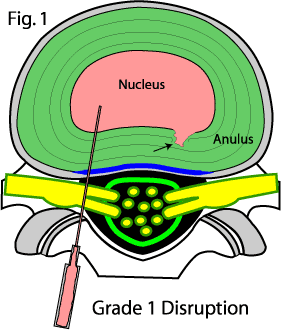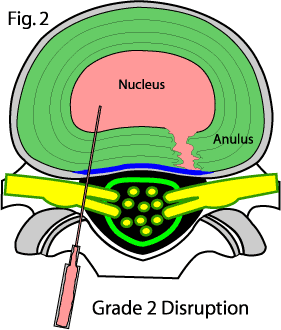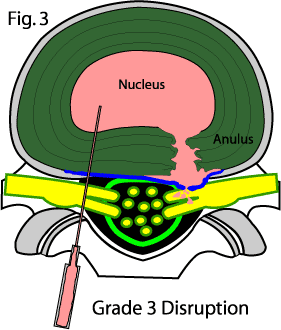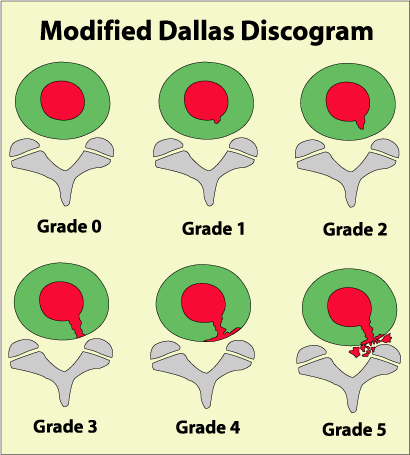The study | Results |Background Material | Discography Tutorial | * Key Result
Ohnmeiss DD, et al "Degree of disc disruption and lower extremity pain" Spine - 1997; 22(14):1600-1665 (also in several other journals in 1999)
This famous study sure cast some doubt on the old adage that radiating lower limb pain (i.e., radiculopathy, radicular pain, or sciatica) is caused only by the compressive effects of disc herniation or stenosis. There are clearly other things that cause radiating limb pain, which include annular tears (annular tears are also called internal disc disruption or IDD for short).
Ohnmeiss et al. studied the different types of annular tears and surprisingly discovered that grade 2 annular tears (a non-complete rupture of the disc) produced lower extremity pain just as often as grade 3 annular tears (a disc that is completely ruptured). Furthermore, the researchers discovered that approximately 60% of both types of IDD reproduced lower limb pains on Provocative Discography. This study supports the theory that nuclear material alone in the outer region of the posterior annulus (without physical sciatic nerve root compression from a disc herniation) may cause sciatica on its own.
The bottom line: before this study was published, the prevailing theory was that the farther/more severe the annular tear, the farther the pain would travel down the patient's lower extremity. For example, a full thickness/grade 3 annular tear would refer pain all the way down the patient's lower extremity into the foot; where as, a grade 2 annular tear (not as deep/long a tear) would only refer pain into the patient's thigh). However, this study discovered this was not the case--there is no correlation between the degree of annular tear and the degree of the patient's sciatica. This investigation also demonstrated that a full thickness annular tear had a strong tendency to refer pain into the lower limbs and often, even below the level of the knee, as noted in 90% of such cases.
Many patients have complaints of lower extremity pain without having bulging or herniated lumbar discs. Addison (100) was the first to note several other conditions that mimicked disc herniation-induced sciatica. As we will discover below, sciatica is not always from the compression of the lumbar nerve root or DRG, although some researchers beg to differ on this point (1). Others have noted that 'Referred pain' down the lower limb may arise from other spinal structures, such as the spinal ligaments, paravertebral musculature, and facet joint capsules (104, 107, 109,120). Since these spinal structures are well innervated, it is not inconceivable that the stimulation of the C-fiber within the outer regions of the annulus (via nuclear material which contained biochemicals called cytokines) may also cause this same referred lower limb pain.
Since at least the outer 1/3 of the disc is innervated (has tiny pain carrying nerve fiber) by type C-afferent nerve fiber (103, 132, 106, 131), we know the disc is capable of causing pain on its own, without the involvement of the posterior neural structures (dura, nerve roots, and DRG). This type of pain is called discogenic pain.
Modern research has taught us that true sciatica (aka: root pain or radiculopathy or radicular pain) is a complicated phenomenon and to this day is still not completely understood. We used to think that sciatica was caused by the mechanical compression of a nerve root, but by the late 1950s, investigators had found that sciatica did not always occur immediately following manual compression, tension or even traction of normal nerve roots. On the other hand IF those roots were swollen or inflamed, then manual stimulation during surgery did indeed reproduce the patients concordant lower limb pains (1,129). It seems that 'something' seems to 'sensitizing' the nerve root. This 'something' in now believed to be biochemical agents (cytokines {especially one called tumor necrosis factor alpha}) that are released from the herniated nucleus pulposus and/or the tissue of a degenerated disc and so the adjacent nerve roots, which in turn causes this sensitization and/or inflammation. Once sensitized, look out!
"There are studies quite a few studies that support the hypothesis that in disrupted discs (IDD) a biochemical or neurochemical reaction occurs [within the outer 1/3 of the posterior anulus] that in turn stimulates the nerve roots or the dorsal root ganglion, via an inflammation reaction, (105, 116, 131) especially if the outer layers of the annulus are leaking nuclear material." (115, 123, 124)
The patient's perception of his pain has also been studied. An aching pain seems to be associated with discogenic pain (121,112), where as symptomatic disc disease seems to be associated with a more 'burning' type pain. (121)
One hundred and eighty seven patients, all of whom were suffering chronic lower back pain and had failed to respond to an average of 16 months of conservative medical care were entered into this study. The patients were all candidates for fusion surgery. Each patient filled out a detailed 'pain drawing' that described the exact location and type of pain. Provocative CT discography was then performed on each patient and the appearance of any axial-disc-defect was noted. The CT, provocation results, and pain-drawings were studied and categorized.
The pain drawings that were made the day before discography were grouped into three categories:
| Low Back Pain & Buttock Pain: | The patients ONLY had complaints of lower back pain. NO pain extended into the lower limb. |
| Back Pain, extending into Thigh: | The patients ONLY had lower back pain with pain extending into the thigh. |
| Back Pain, extending past the Knee: | The patients ONLY had lower back pain with pain extending PAST the knee and into the leg. |
* Any "unusual" pain drawings that did not conform to the typically know pain patterns of IDD and disc herniation-induced sciatica were excluded from the main study via the standard guide lines of Ransford et al. (125) In other words, they weeded-out the patients whose cases were complicated with comorbid conditions: fibromyalgia, chronic pain syndrome, litigation syndrome, etc.
We are going to need to discuss discography. If your unfamiliar with the axial anatomy of the disc, please take a moment to go to my 'Disc Anatomy' page for a quick review.
CT Discography: The Original Dallas Discogram Description:
All of the patients in this study underwent provocative discography, which is considered the 'gold standard' when it comes to diagnosing discogenic pain. For some reason they used the original "Dallas Discogram Classification system" (126,118), which has been twice modified (for the better) for today's usage.
Here's a summary of the 'Original Dallas Discogram Classification System':
 Grade 0: Normal non-leaking nucleus - all the contrast material stays within the nucleus after injection.
Grade 0: Normal non-leaking nucleus - all the contrast material stays within the nucleus after injection.
Grade 1: Annular tearing confined to the inner region of the anulus fibrosus - Fig. #1 demonstrates what this might look like on axial CT imagery (although the needle that delivered the contract material into the center of the disc would be long-gone by this time). Note the needle has injected a radio-opaque dye (pink) into the center of the disc (nucleus) which is used as a 'marker'. At about 5 O' Clock (black arrow) a 'tear' or 'fissure' has become visible from the leakage of some contrast material. It extends from the nucleus radially into the inner 1/3 of the anulus fibrosus. This fissure would probably not be painful since there are usually no pain fibers in this region. This could be described as a 'Grade 1 Radial Anular Tear', or Grade 1 Internal Disc Disruption (IDD).
 Grade 2: Annular tearing has completely disrupted the disc but has NOT affected the outer contour of the anulus, i.e., no leakage, no bulging, or no herniation - Figure #2 demonstrates that there has been a progression or worsening of the anular tear/fissure. Now the entire anulus has been disrupted (torn through), except for the very outer fibers and the PLL (blue) as denoted by the pink contrast material that has now moved from the nucleus through the anulus. Note that there is no leakage of dye from the disc, nor is there any bulging or protrusion of the disc. This would be classified as Grade 2 IDD or a Grade 2 radial anular tear. Despite no compressive effect on the right nerve root (yellow) (which later converges into the sciatic nerve), many of these patients (suffering Grade 2 IDD) suffered lower back pain which traveled into the lower limb and even past knee into the lower leg and foot.
Grade 2: Annular tearing has completely disrupted the disc but has NOT affected the outer contour of the anulus, i.e., no leakage, no bulging, or no herniation - Figure #2 demonstrates that there has been a progression or worsening of the anular tear/fissure. Now the entire anulus has been disrupted (torn through), except for the very outer fibers and the PLL (blue) as denoted by the pink contrast material that has now moved from the nucleus through the anulus. Note that there is no leakage of dye from the disc, nor is there any bulging or protrusion of the disc. This would be classified as Grade 2 IDD or a Grade 2 radial anular tear. Despite no compressive effect on the right nerve root (yellow) (which later converges into the sciatic nerve), many of these patients (suffering Grade 2 IDD) suffered lower back pain which traveled into the lower limb and even past knee into the lower leg and foot.
 Grade 3 : Anular tearing has now completely disrupted the anulus and posterior longitudinal ligament (PLL) (Blue) and deformed the contour of the posterior disc. figure # 3 demonstrates a 'full thickness anular tear' in which the anulus, outer anulus (Sharpey's Fibers), and PLL have been completely ruptured. Contract material is seen leaking out the back of the disc into the epidural space. The presents of a 'disc bulge' and/or 'disc herniation' is also inclusive in this category - with or without leaking into the epidural space. This presentation is classified as 'Grade 3 IDD', (aka: Full thickness tear, Grade 3 radial anular tear). Surprisingly, this more serious form of disc pathology produced the same percentage of patients suffering sciatica as did the Grade 2 IDD patients? This appears to indicate the nerve fibers in the posterior anulus are a strong trigger for the perception of sciatic pain in the lower limbs.
Grade 3 : Anular tearing has now completely disrupted the anulus and posterior longitudinal ligament (PLL) (Blue) and deformed the contour of the posterior disc. figure # 3 demonstrates a 'full thickness anular tear' in which the anulus, outer anulus (Sharpey's Fibers), and PLL have been completely ruptured. Contract material is seen leaking out the back of the disc into the epidural space. The presents of a 'disc bulge' and/or 'disc herniation' is also inclusive in this category - with or without leaking into the epidural space. This presentation is classified as 'Grade 3 IDD', (aka: Full thickness tear, Grade 3 radial anular tear). Surprisingly, this more serious form of disc pathology produced the same percentage of patients suffering sciatica as did the Grade 2 IDD patients? This appears to indicate the nerve fibers in the posterior anulus are a strong trigger for the perception of sciatic pain in the lower limbs.
The 'Modified Dallas Discogram Description' was finalized in the 1990's and is the 'Gold Standard' for the CT classification of anular tears. It was initially developed by a group of researchers from Texas (as described above in detail) (126), 'modified' by Bogduk et al. (7) in 1992, and then finally modified by Schellhas et al. in 1996(15). Below is a brief look at what that system looks like: (Sorry for getting off topic here!)
 The chart on the left demonstrates the five possible severities of the radial anular tear, as seen on an axial CT image. (In reality things are not always so 'nice and need' on discography but often they are.) The grade 0 is a normal disc, where no contrast material (red stuff that was injected into the center of the disc) has leaked from the confines of the nucleus. The grade 1 tear has leaked contrast material but only into the inner 1/3 of the anulus. The grade 2 tear has leaked contrast from the nucleus into the outer 2/3s of the anulus. The grade 3 tear has leaked contrast completely through all three zones of the anulus. This tear is now believed to be painful since the outer 1/3 of the disc has many tiny nerve fibers that may now be irritated. The grade 4 tear further describes the grade 3 tear, in that, now the contract has spread circumferentially around the disc, often resembling a ships anchor. To qualify as a grade 4 tear tear, the circumferential spread must be greater than 30 degrees. (Pathologically, this represents the merging of a full thickness radial tear with a concentric anular tear.) The ‘evil’ grade 5 tear describes either a grade 3 or grade 4 radial tear that has completely ruptured that outer layers of disc and is 'leaking' contract material from the disc into the epidural space. This type of tear is thought to have the ability to induce a severe inflammatory reaction in 'some' peoples posterior neural structures. In some cases this inflammatory process is so severe is causes a painful 'chemical radiculopathy' and sciatica 'without' even the presents of nerve root compression.
The chart on the left demonstrates the five possible severities of the radial anular tear, as seen on an axial CT image. (In reality things are not always so 'nice and need' on discography but often they are.) The grade 0 is a normal disc, where no contrast material (red stuff that was injected into the center of the disc) has leaked from the confines of the nucleus. The grade 1 tear has leaked contrast material but only into the inner 1/3 of the anulus. The grade 2 tear has leaked contrast from the nucleus into the outer 2/3s of the anulus. The grade 3 tear has leaked contrast completely through all three zones of the anulus. This tear is now believed to be painful since the outer 1/3 of the disc has many tiny nerve fibers that may now be irritated. The grade 4 tear further describes the grade 3 tear, in that, now the contract has spread circumferentially around the disc, often resembling a ships anchor. To qualify as a grade 4 tear tear, the circumferential spread must be greater than 30 degrees. (Pathologically, this represents the merging of a full thickness radial tear with a concentric anular tear.) The ‘evil’ grade 5 tear describes either a grade 3 or grade 4 radial tear that has completely ruptured that outer layers of disc and is 'leaking' contract material from the disc into the epidural space. This type of tear is thought to have the ability to induce a severe inflammatory reaction in 'some' peoples posterior neural structures. In some cases this inflammatory process is so severe is causes a painful 'chemical radiculopathy' and sciatica 'without' even the presents of nerve root compression.
Severity of disc disruption versus pain degree of sciatica on discography.
144 Patients Complaints: |
Symptomatic Grade 2 disc |
Symptomatic Grade 3 disc |
Back / Buttocks Pain: |
8% or 3 patients |
8% or 5 patients |
Radiation into thigh: |
30% or 11 patients |
30% or 18 patients |
Radiation past knee: |
62% or 23 patients |
62% or 37 patients |
Note that 25% of the patients had negative discograms despite most having leg & thigh pain. |
||
You would think that the painful grade 3 discs would correlate more strongly with grade III sciatic pain (lower limb pain which passes the knee) since it has the ability to chemically irritate the posterior nerve roots (which lead directly down the lower limb as the sciatic nerve). WRONG! As noted in the results above, BOTH grade 2 and grade 3 disc disruption were equally associated with lower limb pain which past the knee, i.e., 62% of each group reported such symptoms.
In general, patients with lower extremity pain were "significantly more likely" to have grade 2 and/or grade 3 disc disruption, and painful torn discs on discography when compared to patients without lower extremity pains. Specifically, 84% of patients that complained lower limb pains which passed the knee were found to have painful disc disruption (either grade 2 or 3) on provocative discography.
The study also indicated that not all lower extremity pain was referred from the disc. 33% of the patients with lower extremity pain passing the knee were found NOT to have any painful discs on provocative discography; this was thought to indicate that the disc was NOT the source of pain in their particular pain syndrome and that their 'referred' lower limb pain was possible from any of the following: the 'facet joint', the spinal ligaments, a piriformis syndrome, or the spinal muscles. (100,104,107,109,120) Another possibility is the fact that grade 5 annular tears (the ones which leak contract out the back) are often NOT painful on discography since they can not be pressurized due to the complete tear through its substance. It's kind of like trying to blow up a severely flat car or bike tire. You pump in the air (contrast) in an attempt to pressurize it, but because of the 'hole' (grade 5 anular tear) the air (contrast) runs right out not putting any pressure on any structures.
CONCLUSTION:
So, if you have chronic lower back pain with pain that radiates into the lower extremities and you don't have a compressive disc herniation on MRI, the chances are high (98 out of 120 patients in this study) that the cause of your problem is either grade 2 or 3 internal disc disruption as described by the original 'Dallas Discogram Description' (126).
Noteworthy is the fact that 23% of the patients who had "abnormal pain pattern drawings" (as classified by a high Ransford Pain Drawing Scores), and were NOT included in any of the above findings. Was it fair not to include this group? Was this 'cherry picking'? Maybe this discogenic radicular pain is more complex than this investigation alleges.
This study showed that lower extremity pain was just as likely with symptomatic grade 2 anular tears as it was with symptomatic grade 3 anular tears! Over 60% of both grade 2 and grade 3 IDD had pain symptoms down the lower limb, below the knee and into the leg, i.e., 62.2% and 61.7% respectively. Having the presents of a Grade 2 and grade 3 disc in the same patient yielded an even high chance of having sciatica below the knee, i.e., 72.7%.
"Our findings of lower extremity pain related to Grade 2 disruption (full thickness tear but non-leaking, and no bulging of the posterior disc) supports Mooney's contention that referred pain to the (lower extremity) may be related to abnormalities in the disc itself." (119) "The physiological mechanism of this (refer leg pain ) is thought to be [from] convergence of primary sensory afferents on the dorsal horn neurons of the spinal cord." (100)
The main criticisms I have about this study are the following: 1) They should have reported more information concerning the 'clinical presentation' (especially the neurological examinations) of these patients. It would have been interesting to see if a 'leaking' grade 3 disc yielded more neurological findings that a grade1 or 2 disc. I would expect this to be so. 2) They should have used the more modern "modified dallas naming system", which described 5 degrees of annular disruption instead of the original naming system that few use today. I would bet that a grade 5 disc (worst type) would have yielded more serious neurological findings and a stronger association with grade 3 sciatica than lesser levels of disruption. I guess there wasn't enough grade 3 discs (60 discs) to split up? Or maybe they just didn't have the funding to break things down this much, but that sure would have been interesting! 3) I would have also liked more clarification on each patients exact symptomatology. For example, I would have liked to see a chart showing: low back pain, butt pain, thigh pain, leg pain, foot pain. I would also have loved to know if any of these patients had NO lower back pain but only lower limb complaints. 4) These results are 'skewed' due to the fact that they threw-out 23% of the participants because of abnormal pain drawings! They should have allowed these patients to participate anyway and given the results both with and without their participation.
I would say that this study was rather 'loosely done (or presented), but never the less it was a quite interesting Investigation. Its results, although impressive, were not nearly as conclusive as the work of Kuslich et al. (1), who found NO relationship between stimulation of the outer annulus and the reproduction of lower limb pain (sciatica) during open surgery (while the patients were awake and responding to different stimulation of spinal tissues), but did find a 99% probability for the reproduction of concordant sciatica with the stimulation of an inflamed and/or compressed nerve root.
References:
1) Kuslich SD, et al. "The Tissue Origin of low back pain and sciatica: A report of pain response to tissue stimulation during operations on the lumbar spine using local anesthesia." Orthopedic Clinics of North America 1991; 22(2):181-187
7) Aprill C, Bogduk N, "High Intensity Zone" - The Brit Jour Radio 1992; 65, 361-369
15) Schellhas KP , et al. "Lumbar Disc High-intensity Zone - MRI & Discography" - Spine 1996; 21:79-86
100) Ohnmeiss DD, et al "Degree of disc disruption and lower extremity pain" Spine - 1997; 22(14):1600-1665
105) Garfin SR, et al. "Compressive neuropathy of spinal nerve roots: A mechanical or biological problem?" Spine - 1991; 16:162-5
112) Ljunggren AE, "Descriptions of pain and other sensory modalities in patients with lumbago-sciatica and herniated intervertebral discs:" Pain 1983; 16:265-76
115) Marshall LL, et al. "Chemical radiculitis: A clinical, physiological and immunological study." Clin Orthop - 1977:129:61-7
116) McCarron RF , et al. "the inflammatory effect of nucleus pulposus: A possible element in the pathogenesis of low back pain." Spine - 1987; 12:760-4
118) Moneta GB, et al. "Reported pain during lumbar discography as a function of anular disruption and disc degeneration." Spine 1994; 19:1968-74
119) Mooney V. "Where is the pain coming from?" Spine 1986; 12:754-9
121) Ohnmeiss DD, et al. 'Relationship of pain drawings to invasive tests assessing disc pathology. Presented at the annual meeting of the North American Spine Society, October, 1995, Washington , DC .
123) Olmarker K, et al. "Ultrastructural changes in spinal nerve roots induced by autologous nucleus pulposus." Spine - 1996; 21:411-4
124) Olmarker K, et al. "Autologous nucleus pulposus induces neurophysiologic and histologic changes in porcine cauda equina nerve roots. " Spine - 1993; 18:1425-32
126) Sach BL, et al. " Dallas discogram description: A new classification of CT/discography in low back disorders. Spine 1987 ;12:287 -94
129) Smyth MJ , Wright V, "Sciatica and the intervertebral disc: an experimental study." J Bone Joint Surg [Am] - 1958; 40:1401-18
Top | Research Corner | Kuslich et al. | Home